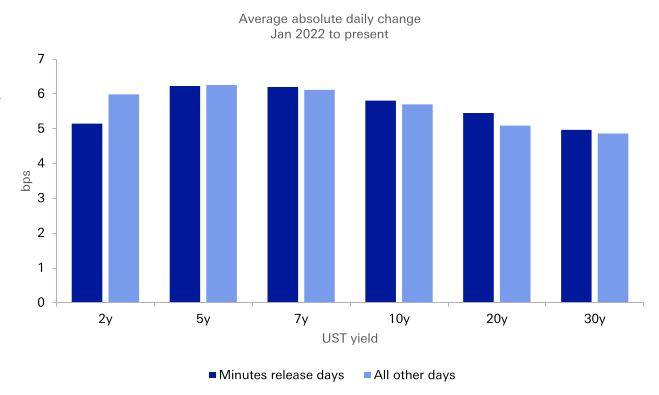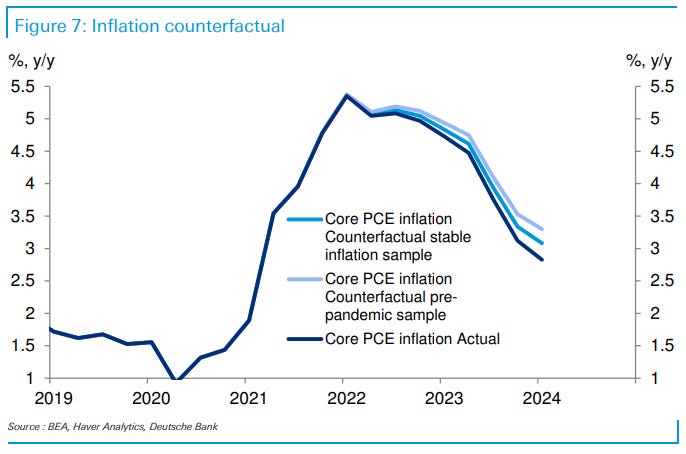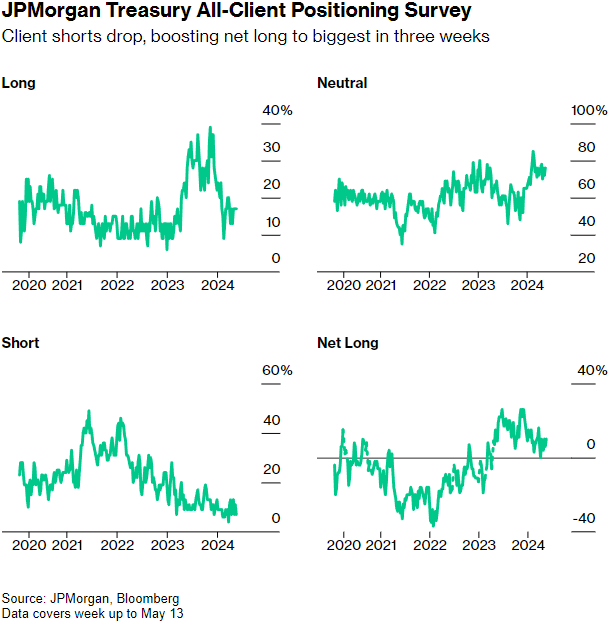while WE slept: belly leads USTs cheaper on light volumes; "Bond Traders Trim Fed Rate Cut Bets With Treasury Shorts Revived"; #Got20s?
Good morning and some GOOD news…
Reuters: Nvidia vigil almost over
… and I’ve STILL nothing to add to that conversation and so, I won’t even try.
I WILL, however, acknowledge that I missed an important date and so a very belated happy Taper Tantrum A versary to you all…
… How time flies. Yesterday was the 5th anniversary of the start of the taper tantrum as Mr Bernanke hinted at an upcoming reduction in stimulus and created a few weeks of mini-panic. Meanwhile we’re only a few months away from the 10th anniversary of the Lehman Brothers collapse and its 6 and half years ago this week that Italy was on the brink with 10 years yields at over 7.25% and around +500bp over Bunds. Makes one feel very old…
-DBs Jim Reid (23 May 2018)
… That would make yesterday the 11th anniversary (May 22, 2013 — investopedia HERE for what it was and what caused it and HERE is Bernanke SPEECH) which a quick Google search reveals the traditional gift of … steel, symbolizing strength of relationship.
On THAT note, then, I’m once again humbled and in that position of saying thanks and expressing my sincere gratitude to those who’ve recommended this spot on the intertubes … I appreciate the kind words more than you might imagine … A very big welcome to any / all the newcomers and I hope I don’t let you down and you find whatever it is you may be searching for.
Here’s to HOPING our relationship makes it 11yrs and is as solid as STEEL. Heck lets just HOPE y’all stay 11minutes!!
On with ‘the show’ and back TO Taper Tantrum A Versary … HERE is p1 of what I said back on May 22, 2020 …
… in my former seat I produced this 2pg macro daily and MY VIEW was there for clicking.
Moving on from then to NOW it’s arguably been a very slow news week continually peppered with important (ie voting)FOMC members clamouring for attention .. Enter exhibit 2,422 on the week …
CNBC: Fed Governor Waller wants ‘several months’ of good inflation data before lowering rates (and does say it’s likely to NOT have to RAISE ‘em … see whatever you wanna see)
Meanwhile, whenever HE speaks …
Board of Governors
Little by Little, Progress Seems to be Resuming.
Governor Christopher J. Waller… After a run of great data in the latter half of 2023, it seemed that significant progress on inflation would continue and that rate cuts were not far off. However, the first three months of 2024 threw cold water on that outlook, as data on both inflation and economic activity came in much hotter than anticipated. Initially it seemed like the bad data might be simply a “bump” in the road, but as the data continued to point in the wrong direction, the narrative quickly turned towards concerns that the economy was not cooling as needed to keep inflation moving down toward the Federal Open Market Committee’s (FOMC) 2 percent goal. Progress on inflation appeared to have stalled and there were fears that it might even be accelerating. Suddenly, the public debate became whether monetary policy was restrictive enough and if rate hikes should be back on the table.
But more recent data on the economy indicate that restrictive monetary policy is helping to cool off aggregate demand and the inflation data for April suggests that progress toward 2 percent has likely resumed. Central bankers should never say never, but the data suggests that inflation isn’t accelerating, and I believe that further increases in the policy rate are probably unnecessary…
… While the April inflation data represents progress, the amount of progress was small, reflected in the fact that I needed to report the monthly numbers to two decimal places to show progress. The economy now seems to be evolving closer to what the Committee expected. Nevertheless, in the absence of a significant weakening in the labor market, I need to see several more months of good inflation data before I would be comfortable supporting an easing in the stance of monetary policy
… well, I cannot help but close my eyes and see this guy talkin’ monetary policy …
… always have and always will. Sorry, not sorry.
Moving on … #Got20s?
If not, today’s your chance especially if you subscribe to the process of thought (equity risk premium the years MOST compelling chart for buying bonds, laid out HERE (and noted yesterday)
… momentum is BEARISH while we romance the bottom of the UPTRENDING CHANNEL … make of it whatever you will and ahead of this afternoons auction and FOMC minutes, an interesting ZH hit just AFTER markets closed where 1st couple words sums up things very well …
ZH: Stocks Inch Higher As Fearless Vol-Sellers Continue To Push Ahead Of NVDA/FOMC Mins
It's quiet... too quiet...
… here is a snapshot OF USTs as of 705a:
… HERE is what this shop says be behind the price action overnight…
… WHILE YOU SLEPT
Treasuries are cheaper, led by the belly, with volumes running ~65% the 30d average. A large bear-steepening in JGBs (30y +7bps) was seen overnight after the well-received 40y auction, direct bids underwhelming, suggesting lifer demand was very limited. USDJPY (+0.2%) still remains stronger however, while a beat in UK CPI has seen the UK front-end come under severe pressure despite optimistic Bailey comments (UK 2s +13bps). Our desk has seen light cash buying in the front end from real money. In swaps, we've seen better paying in 10s and spreads have generally been better bid. Metals are heavy with copper (-2.5%) and XAG (-0.4%), while Crude (-0.5%) and Gasoline (-1%) are on the back foot as well. APAC stocks were mixed (NKY -0.8%, Sensex +0.4%, SHCOMP flat), while the DAX is -0.2% and S&P e-minis are -8pts here at 7am.
… and for some MORE of the news you might be able to use…
IGMs Press Picks: May 22 2024
NEWSQUAWK: US Market Open: Equities trade tentatively ahead of FOMC Minutes & NVDA earnings, Bonds subdued post-UK CPI … Bonds are lower after hotter-than-expected UK CPI metrics, with Gilts the clear underperformer … USTs are softer following the broader dynamics in fixed income markets but to a lesser extent than peers. Today's FOMC minutes will be parsed for details on what lies ahead for the Fed. Trough thus far at 108.31+ low matched that of yesterday's but failed to make any headway below that level.
Reuters Morning Bid: Nvidia nears, UK CPI lunge misses target
Finviz (for everything else I might have overlooked …)
Moving from some of the news to some of THE VIEWS you might be able to use… here’s SOME of what Global Wall St is sayin’ …
DB: Do the FOMC minutes matter? (look, it’s a slow news week so this all we got)
Not generally. Or at least they haven’t been a vol event this cycle.
As shown in today’s chart, since the Fed began hiking in early 2022, average absolute daily changes in Treasury yields on FOMC minutes days (dark blue) have been indistinguishable from changes on other days (light blue). That likely reflects that the minutes can often be “stale” given data and communications that come in the three weeks between the meeting and their release.
In tomorrow’s minutes, we’ll be looking for anything that fleshes out the Committee's thinking on the reaction function. A key change to Chair Powell’s prepared press conference remarks in May was his omission of the line that stated, “it will likely be appropriate to begin dialing back policy restraint at some point this year,” and in Q&A he focused on the economic conditions that would call for cuts rather than on their timing. We’ve interpreted most comments from FOMC participants since then as also reflecting a general shift away from calendar-based forward guidance. In theory this could make Fed pricing somewhat more sensitive to incoming data, but any related effect is likely to be small in practice.
We’ll also be interested in discussion around the changes to QT that the Committee made at the meeting. The reduction in the Treasury runoff cap from $60bn to $25bn was a bit bigger than consensus. This could be because, with MBS runoff left unchanged, a slightly larger reduction in the Treasury cap was needed to cut the overall QT pace roughly in half; operational considerations may also have factored in. In any event, the Committee has very effectively separated interest rate and balance sheet policy – with the fed funds rate as its active tool – and QT should (for a time) become sleepy again following the recent burst of broader market focus.
The FOMC minutes have not been a vol event this cycle
DB: How large was the inflation mitigation from immigration? (short version sounds like — orangeman BAD … orangeman = INflation … dunno, maybe i’m wrong)
Last year was the best outcome for the US economy the Fed could have hoped for when they embarked on a historic rate hiking cycle in early 2022 – the economy grew more than 3%, the unemployment rate remained below 4%, and core PCE inflation was below the Fed's objective over the back half of the year. What drove this surprising outcome? One factor was a positive supply shock from a surprising surge in net immigration flows.
In this note, we quantify the disinflation effects of this positive supply shock. We do this by constructing counterfactual labor market variables assuming the absence of this surge in net immigration. We then translate these into counterfactual paths for inflation. Absent the surge in immigration, we find that core PCE inflation could have been 25-50bps higher.
This analysis is not only important for a backward looking assessment of what drove last year's disinflation. With the presidential election possibly leading to different outcomes on immigration policy, the inflation outlook is likely to be impacted by such policy decisions. To the extent that immigration flows are curtailed, this would act as a negative supply shock, dampening growth while providing a tailwind for inflation.
Goldilocks: Waller Speech Raises Risk of a Later First Cut
BOTTOM LINE: Comments by Governor Waller in a speech today raise the risk that the first cut could come later than our forecast of July. Waller said that he would “need to see several more months of good inflation data before [he] would be comfortable supporting an easing in the stance of monetary policy.” With only two months of inflation readings between now and the July meeting, a threshold of “several” months would suggest that the bar for inflation alone to motivate cuts is fairly high. We have not made any changes to our forecast at this stage, however, as his views may not be representative of the FOMC as a whole and further softening in the labor market or activity data over the next couple of months—in combination with moderate improvement in the inflation data—should convince the FOMC to begin normalizing policy sooner than Waller’s timeline.
Goldilocks: The Challenge of Fiscal Sustainability with Higher Interest Rates
The outlook for US fiscal sustainability has become more challenging over the last five years. The primary deficit—the deficit excluding interest costs on the debt—remains roughly 5% of GDP wider than it has been historically at full employment, the debt-to-GDP ratio has risen 19pp to 98% and will likely soon surpass the post-WW2 high, and interest rates on new Treasury debt have roughly doubled. Higher expected future interest rates in particular have substantially worsened the trajectories of the debt-to-GDP ratio and of real interest expense as a share of GDP
We update our debt projections using our long-term forecasts for the average interest rate on government debt, nominal GDP growth, and the primary deficit outside of recessions. We follow our earlier fiscal sustainability analysis in accounting for the impact of recessions on the deficit and of the rising debt stock on interest rates. We now project that the current fiscal path would push the debt-to-GDP ratio to 130% by 2034 (vs. 97% in that year under our 2019 projections) and real interest expense to 2.3% of GDP (vs. 1.5%).
The trajectory of debt-to-GDP is highly sensitive to the assumed gap between the interest rate and GDP growth, or r-g. Our baseline forecast assumes an r-g differential of -0.25pp, which is roughly in line with the historical average outside high inflation episodes and below the market-implied level. The debt-to-GDP ratio would rise substantially in most scenarios as long as the current primary deficit persists, but it would rise meaningfully less if GDP growth is stronger than we anticipate.
Historical episodes of debt and deficit reduction in the US and other advanced economies offer a few lessons about potential paths to fiscal sustainability. First, large reductions in the debt-to-GDP ratio have been achieved in a variety of ways—some entirely with sustained fiscal surpluses, others with combinations of a favorable natural r-g, high and unexpected inflation, and financial repression.
Second, countries are more likely to reduce fiscal deficits when interest expense is a larger share of GDP and especially when interest rates rise meaningfully, when GDP is growing more rapidly, and when political fragmentation is high and restrains spending. These fiscal consolidations are more likely to succeed in reducing the debt-to-GDP ratio when growth is high, central banks ease in response to the fiscal contraction, and the private sector is not financially vulnerable
Third, while it is not historically unusual that countries run balanced budgets for long periods, it is unusual that countries maintain large surpluses for long periods. For example, advanced economies have only averaged a 1.5% primary surplus during 10% of 20-year periods and 5% of 40-year periods.
Our analysis implies that if r-g rises with a growing debt stock, the current fiscal trajectory could eventually push the debt-to-GDP ratio to a point where stabilizing it would require a fiscal surplus of a size that has rarely been sustained historically. And while the conditions for a fiscal consolidation to succeed are currently in place in the US, there is little political momentum for deficit reduction.
UBS: Cutting comments
European Central Bank President Lagarde did, after all, offer policy comments yesterday—in an Irish TV interview. Lagarde signaled a June Euro area rate cut is coming, because inflation is under control. Markets already expect this. Currently, US inflation is the same as that of Europe when measured on a like-for-like basis, so why is the Federal Reserve delaying rate cuts?
Politicization may be part of the problem. Politicians (in all countries) like things kept simple. For years US politicians focus on the headline consumer price index, despite its flaws as a price measure. Since the policy errors of mid-2022, Fed Chair Powell clearly wants to hang out with the cool kids in Congress rather than the geeks of the economics club. This means other inflation measures are overlooked, despite signaling that cuts might be appropriate.
… And from Global Wall Street inbox TO the WWW,
AllStarCharts: Dollar Down? The 10-Year Says “Yes! (FX and rates in one hit)
… Earlier this month, the US Treasury benchmark interest rate led the US Dollar Index $DXY in violating a year-to-date trendline.
Here’s the US 10-year yield $TNX overlaid with DXY:
The dollar follows the same path as rates. Therefore, the US dollar should follow if the 10-year yield is posting a valid breakdown…
Bloomberg: Bond Traders Trim Fed Rate Cut Bets With Treasury Shorts Revived (when Ed Bollingbroke writes we should read … great stuff here…)
Front-end shorts have rebuilt, longs unwound in recent days
Swaps price in less than 50 basis points of rate cuts for year
… Add Duration
In the week up to May 14, asset managers added to net duration long position for the fifth week in a row, by an amount equivalent to around 290,000 10-year note futures. The duration add of around 1.4 million 10-year note futures equivalents since April 16 has taken the overall duration long among investors to north of 7.5 million contracts, a record amount.Hedge funds have continued to take the other side, adding to net duration short by around 145,000 10-year note futures equivalents and are net duration short at almost 7 million contracts.
Shorts Trimmed
In the week up to May 20, JPMorgan clients cut short positions by 4 percentage points, shifting into neutral while long positions were unchanged at 17%. The net long position for all clients is now back to the largest since May 6.Bloomberg: Morgan Stanley’s Wilson Says Bonds Pose Biggest Risk to the Stock Market (another important spin / take from Wilson)
… A lot depends on bonds. Wilson thinks valuations in stocks depend entirely on whether Treasury investors continue to finance the deficit with relatively cheap yields on government debt. He didn’t use the words“Liz Truss moment,” but that’s what he was getting at — the risk of a we-won’t-take-this-anymore reaction by the bond market. Goodbye, liquidity.
… “Ultimately the 5,400 is being supported by policy — by very loose fiscal and monetary policy,” Wilson said. “To me the risk in the story for the next six to 12 months is, do the markets start to balk at thisunsustainable fiscal policy and the way that they’re funding it?”
Bloomberg: The Fed’s Uniformity on Rates Comes With Risks (El-Erian OpED)
The high-for-long mantra recently adopted by US central bank policymakers raises threats for the economy and financial stability.
… and as the wait is almost over, Global Wall Street’s current ‘beer goggles’ view
AND … THAT is all for now. Off to the day job…












